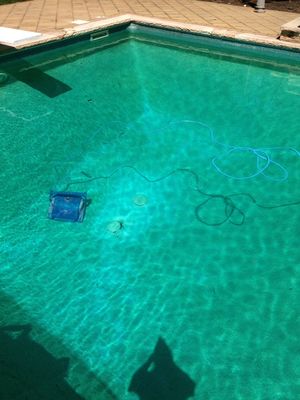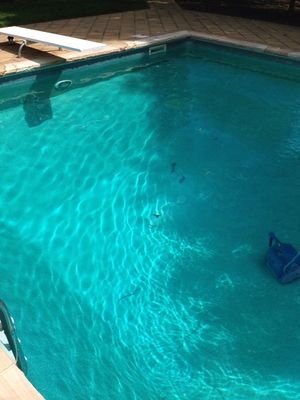| Line 1: | Line 1: | ||
| − | = | + | =How to Lift Metal Stains Using Ascorbic Acid= |
Here are the directions to use Ascorbic Acid treatment to rid your pool of metal stains:<ref>https://www.troublefreepool.com/threads/ascorbic-treatment-to-rid-pool-of-metal-stains.2129/</ref> | Here are the directions to use Ascorbic Acid treatment to rid your pool of metal stains:<ref>https://www.troublefreepool.com/threads/ascorbic-treatment-to-rid-pool-of-metal-stains.2129/</ref> | ||
[[File:AA Treatment Before.jpg|thumb]] | [[File:AA Treatment Before.jpg|thumb]] | ||
Revision as of 16:19, 31 August 2019
How to Lift Metal Stains Using Ascorbic Acid
Here are the directions to use Ascorbic Acid treatment to rid your pool of metal stains:[1]
- Take your chlorine down to 0 and PH down to 7.2, if there is chlorine in the water it won't hurt, it will just eat up the ascorbic acid, so you will need more to get rid of the stains.
- You can add poyquat 60 per directions on the bottle to avoid getting algae while the chlorine is low.
- You will need about a half to one pound of ascorbic acid per 10,000 gal. Go lighter on it and see if all the stains lift off before adding more.
- Put the filter on circulate.
- Use a cup and go around the perimeter of the pool and drop it down the sides as you go.
- Let the ascorbic acid circulate for 1/2 hour. You will be amazed how the stain just disappears before your eyes.
- If the stain is not all gone, leave the filter in circulate and add more ascorbic acid close to where you still see stain.
- Leave it in circulate until all of the stain is gone. (add more ascorbic acid if it circulates for 1/2 hour and there is still stain)
- When the stain is gone, add enough sequestering agent for the volume of your pool - more is better than not enough.
- Put the filter back on filter and leave it on 24/7.
The ascorbic acid will bring your ph down, and sometimes the alkalinity.
After 24 hours you can start to rebalance the water.
- Bring up your ph and alkalinity, - use Arm and Hammer Washing Soda first, it will raise both ph and alkalinity.
- Make sure you test in between, because you don't want your ph to go any higher than 7.2.
- If your alkalinity is in range, and you still need to raise your ph, use Borax to take it up to no higher than 7.2.
- You can start to bring up your chlorine. You want to do this slowly. It will take a lot of chlorine - I prefer to use bleach only at this time, and try to take it up to your minimum chlorine for your cya according to the Chlorine/CYA Chart.
- As you slowly raise the chlorine, watch for stains starting to form.
- If you see stains, make sure the ph is no higher than 7.2, and add more sequestering agent. You should see the stain lift in a couple of hours.
- Do not shock! Do not shock for at least 2 weeks!
- Make sure you keep your ph low for (7.2) for a week or two - it won't be hard because the ascorbic acid and sequestering agent will help it stay low.
- Once your chlorine starts to hold, it means that you have used up the ascorbic acid in the water and it will be easy to rebalance the pool back to your regular parameters.
Here are two important notes:
- High ph along with high chlorine will precipitate any metals that are not sequestered out of the water and on to the surface of the pool again. If this happens take the ph back down to 7, or 7.2 and add more sequestering agent. This should lift the stain off.
- You can add polyquat 60 to the water before starting the stain treatment to avoid getting algae while the chlorine is low.
Here are two links to buy ascorbic acid:
Since they have really raised the price on Ascorbic acid I tried Citric acid and it worked. Here is a link to citric acid which is cheaper. You will have to use more, and it takes a little longer but it works.
Use Ascorbic Acid or Citrus Acid or Oxalic Acid?
People have settled on ascorbic acid because it seems to work more effectively than citric acid though it is more expensive.[2]
One can compare the different reducing agents by comparing their molecular weights:[3]
- Ascorbic Acid: 176.12 g/mole
- Citric Acid (monohydrate): 210.14 g/mole
- Oxalic Acid: 90.03 g/mole
So 1 pound of ascorbic acid is equivalent to 1.2 pounds of citric acid which is equivalent to 0.5 pounds of oxalic acid.
As described in this paper, chlorine oxidizes citric acid to produce significant amounts of chloroform (a trihalomethane, THM), especially at lower pH, so it is better to use ascorbic acid instead even though it is more expensive.[4]
If you are only using the citric acid for a single treatment and keep your water exposed to air, then that's probably OK, but it is not recommended to use citric acid for repeated multiple treatments.
Another alternative is oxalic acid, but one has to be careful to not overdose or use it in high CH conditions due to the precipitation of calcium oxalate (i.e. it's OK as a local spot treatment, but not so good for a broad amount -- probably no more than 1 ounce per 10,000 gallons). Oxalic acid has a higher toxicity profile (so just be careful not to get it on your hands or inhale dust) though it's still less hazardous than some other chemicals we use for the pool.[5]
Role of the Sequestrant
Ascorbic acid converts iron staining into dissolved iron in the water. Phosphonic acid (and other sequestrants) bind to the iron dissolved in the water and prevent it from redepositing as stains. However the phosphonic acid breaks down over time, so you need to keep adding more to keep the iron in the water. To some extent phosphonic acid can remove stains, but it isn't any where near as good at doing that as ascorbic acid is.
When there is iron in the water, low PH (say around 7.0 to 7.3) tends to prevent staining while high PH (say around 7.8 to 8.2) tends to cause staining. Phosphonic acid helps control this, so that high PH levels can occur without staining. High FC levels also tend to cause staining. As the PH goes up, and/or the FC level goes up, the chances of staining increase. Likewise, as the phosphonic acid level goes down, the chance of staining increases.
ProTeam's Metal Magic and Jack's Magic the Pink Stuff (regular), the Blue Stuff (fresh plaster), and the Purple Stuff (SWG) are some of the top sequestrants. You can also find many other brands with similar products, some of which are noticeably less expensive. Sequestrants based on HEDP, phosphonic acid, or phosphonic acid derivatives are the most effective.[6]
Some clouding of the water after adding sequestrant is completely normal.[7]
Keeping Stains from Returning
Ascorbic acid converts iron staining into dissolved iron in the water. You then have to bind the iron to a sequestrant or replace the water with metal free water.
Replacing the water with metal free water is the best long term solution by far. That is assuming you can get some metal free water. The metals in the pool must have come from someplace. Usually they come from the fill water. "Draining" the pool is one of several ways to replace the water, not usually the best choice however.[8]
Tips
- Putting the filter on recirculate helps avoid the small chance of coating your filter media with metals, which might end up forcing you to replace your filter media. This doesn't usually happen, even if the filter isn't on recirculate, but best to avoid even the small chance of a problem by using recirculate.[9]
- Ascorbic acid is way way way milder than an acid wash. There won't be any plaster etching, though the metals coming off can change the texture of the surface.[10]
- A copper heat exchanger is totally fine for any period of time down to a PH of about 7.0, and won't even notice a week or two at 6.6 or 6.8, though a couple of years at 6.6 or a few weeks at 4.0 would be a problem.[11]
- If you can't wait for to order of AA. Go to your supermarket or hardware store and go to the canning section, (you know, mason jars and stuff). You will find a product called Fruit-Fresh. It is put out by Ball. It is Ascorbic Acid and Citric Acid. It comes in a 5 oz. container and is about $3. It is quick and easy to get and works like a charm.[12]
.
- ↑ https://www.troublefreepool.com/threads/ascorbic-treatment-to-rid-pool-of-metal-stains.2129/
- ↑ https://www.troublefreepool.com/threads/ascorbic-treatment-to-rid-pool-of-metal-stains.2129/post-253401
- ↑ https://www.troublefreepool.com/threads/ascorbic-treatment-to-rid-pool-of-metal-stains.2129/post-253305
- ↑ https://www.troublefreepool.com/threads/added-citric-acid-how-long-will-it-consume-chlorine.36608/post-306847
- ↑ https://www.troublefreepool.com/threads/ascorbic-treatment-to-rid-pool-of-metal-stains.2129/post-253401
- ↑ https://www.troublefreepool.com/threads/ascorbic-treatment-to-rid-pool-of-metal-stains.2129/post-212474
- ↑ https://www.troublefreepool.com/threads/ascorbic-treatment-to-rid-pool-of-metal-stains.2129/post-311731
- ↑ https://www.troublefreepool.com/threads/ascorbic-treatment-to-rid-pool-of-metal-stains.2129/post-146742
- ↑ https://www.troublefreepool.com/threads/ascorbic-treatment-to-rid-pool-of-metal-stains.2129/post-146742
- ↑ https://www.troublefreepool.com/threads/ascorbic-treatment-to-rid-pool-of-metal-stains.2129/post-146754
- ↑ https://www.troublefreepool.com/threads/ascorbic-treatment-to-rid-pool-of-metal-stains.2129/post-211703
- ↑ https://www.troublefreepool.com/threads/ascorbic-treatment-to-rid-pool-of-metal-stains.2129/post-275650



